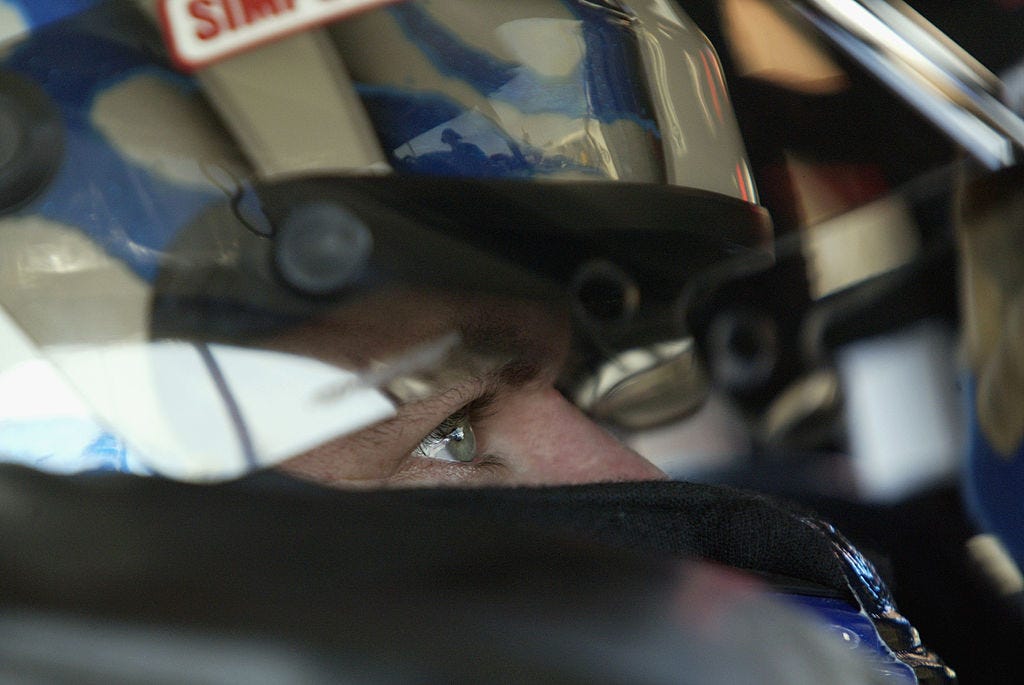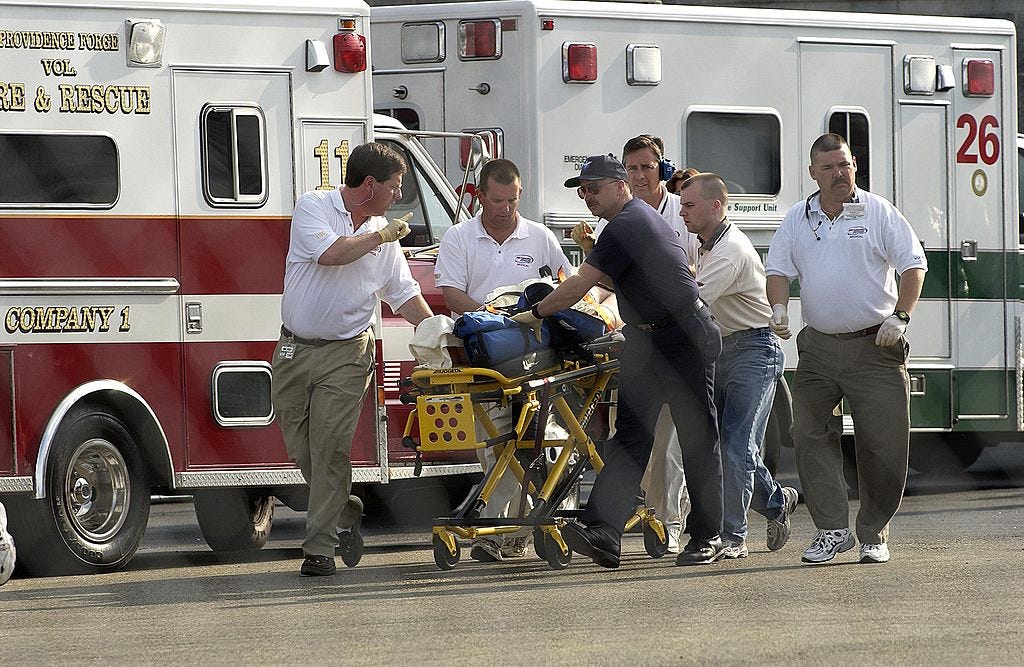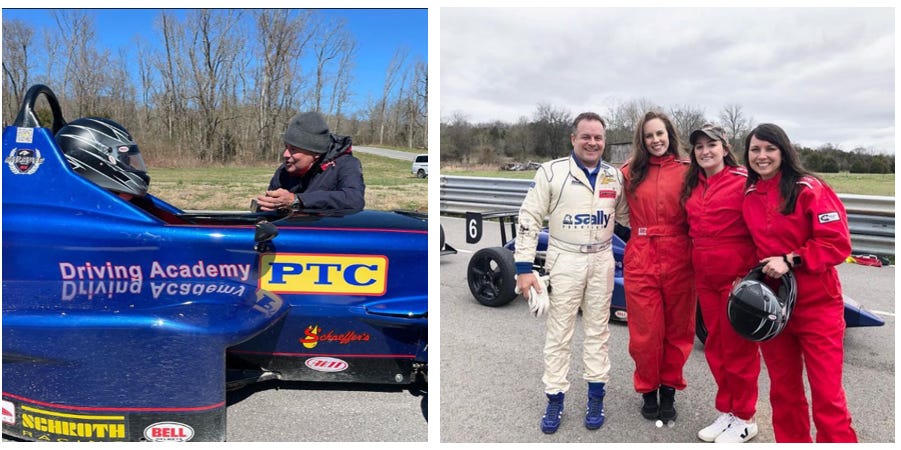|
 |
From NASCAR to ‘Now What?’
A near-fatal accident ended my auto racing career. How do you reinvent your life when you lose the thing that defines who you are?
From the time I was a kid, I knew there was nothing I’d rather do with my life than race cars. When I was really young, I played with toy cars in the dirt at the tracks where my dad raced throughout New England. He got me my first go-kart when I was 4, and I began racing competitively myself when I was just 7 years old. I ended up traveling the world racing—from small tracks in the northeast U.S. to famous venues across Europe. I even raced on ice in Russia just after the fall of the Soviet Union.
But ultimately, I got my big break on one of the biggest stages in auto racing: NASCAR. And when I edged out none other than seven-time NASCAR champion Dale Earnhardt to win a race in the sport’s top division in November 2000, it was the culmination of years—decades, even—of hard work, good luck and a whole lot of passion. I was doing exactly what I was meant to do, and I was loving every minute of it.
Less than three years later, it was all gone.
In May 2003, I was involved in a single-car accident while practicing for a race in Richmond, Virginia. It was the hardest hit ever recorded in a NASCAR wreck, subjecting me to 128Gs—a force equivalent to 128 times the force of gravity. It left me with a fractured shoulder blade, several broken ribs, a punctured lung and—most critically—a severe head injury. My doctors gave me a 6% chance of surviving.
Following my accident, I spent three weeks in a coma. Shortly after I woke up, my neurosurgeon, Dr. Petty, held my hand—I could barely feel it due to the nerve damage on my left side—and told me, “Jerry, I love you like a son. Do me a favor and choose a new profession.”
While I didn’t lose my life in the accident, in a way I did. I had to learn to walk and talk again, and while I got those abilities back, I lost the thing that defined my life: I was no longer able to race. Being alive is definitely a gift, but it created a challenge for me, one that felt (and sometimes still feels) insurmountable: What do I do now that I can no longer do what makes me me?
I never considered what I’d do without racing. And to be honest, I’m still trying to work out what my life looks like when I’m not able to strap into a race car and battle with the best of them. While anyone looking at me today wouldn’t notice much of a difference from the way I was before my accident, a lot of things are different inside—the way I think, the way my body feels. But the crash also changed the way I look at life.
I haven’t recaptured the feelings that I had when I was living out my wildest dreams, but I’ve come to realize that that’s OK: It’s OK that this season of life looks different from what I had imagined. The fact that I’m still here today convinces me that I still have a purpose, even if I don’t quite know what that is yet. But I’m grateful that I get the opportunity to figure it out.
The End of Everything I Knew
The initial aftereffects in the months following my accident were wild. After I’d gotten well enough to drive a passenger car again, I’d get behind the wheel, sometimes forget to put my left leg in the car and end up closing the door on my leg. As a race car driver, I’d had quick reflexes, but now, I’d gone from feeling sharp to feeling like mashed potatoes.
One of the most difficult things for a race car driver is to admit fear—but I was scared. Scared to take another big hit, and scared of what the outcome would be if I did. An MRI after my accident revealed several dark splotches across my brain, souvenirs from previous concussions sustained over years in a race car. And with each concussion, recovery is an increasingly long and difficult process, with less of a guarantee you’ll get back to where you were.
There’s no doubt that I became cautious and careful. When I was well enough to test a race car months after my accident, to see whether I should consider attempting a comeback, I found myself holding back. The words of Dr. Petty echoed in my head—if I took one more hit, that truly might be the end for me. There would be no coming back from it. Without the ability to drive fearlessly, I’d always be at a disadvantage against my competitors. And I thought of my young daughter—just a baby at the time—and my parents, and I realized that as much as I longed to be back on the track, it felt selfish to put my family through that. I knew then that my competitive career was over.
It’s a crazy thing to live your life following a single path and then have that path closed to you: You never think of needing a backup plan. You keep your eyes on the goal ahead, and it’s as if you have blinders on. Everything else is out of sight and out of mind. So, when it became clear that the life I’d worked so hard for had come to an end, I felt the kind of grief that comes with any major loss. I’d been racing my whole life. I barely graduated high school because I was so focused on getting my professional driving career off the ground.
I don’t know if you could call what I was feeling “depression” in the clinical sense, but I felt depressed for sure. A bad day would send me back to bed, or to the couch with pizza and a movie. I often felt sorry for myself or unmotivated. Even when well-wishers or possible opportunities came calling, I didn’t want to answer the phone.
What these feelings boiled down to was that I didn’t really know who I was without racing. I’ve always been a racer in my bones—I still am. But the accident created a mismatch between my desire to race and my ability to do it, and as much as I wanted them to match up again, it just wasn’t possible. And that left me feeling totally lost.
Racing, Round Two
In the 20-plus years since my accident, I’ve learned that the journey to finding a new purpose—to redefining who I am—isn’t a linear one. It’s got false starts, paths that don’t end up leading anywhere and paths that haven’t opened up yet. I’d love to do more talks to raise head injury awareness, for example, but the right opportunity hasn’t come my way just yet. I’d love to get involved working with a race team again, maybe helping to develop the next generation of talent, but the chance hasn’t come around.
On top of that, my relationship with racing is, not surprisingly, a bit complicated. Honestly, I’ve sometimes found it painful to return to the NASCAR tracks because of what happened to me. But while my accident took away my ability to race, it didn’t take away my passion for racing, especially the dirt races, the local short track races—basically, racing that’s based less on computers and more on brute force, smart strategy and raw talent.
Fortunately, my work today sometimes does put me behind the wheel of a race car. A couple of years back, a driving school in Tennessee, PTC Driving Academy, reached out to me to see if I’d be interested in being an instructor. Now, several times a year, I spend weekends at the track and teach the basics of competitive driving to would-be racers—everything from car control to braking to finding the best angles of entry into a corner to maximize speed. We use Formula Fords—little open-wheel cars that are challenging to drive but a lot of fun—and we teach everyone from people looking to obtain racing licenses to total newbies.
I’ve become more comfortable over the years since my accident with staying involved in racing in ways that don’t include driving myself—and that’s why I find my work with PTC satisfying. Since I’ve been working with PTC, I’ve found that I really enjoy teaching: I get excited about passing along the know-how needed to race, and I love seeing the people I teach light up as they discover a new passion.
Even more than that, I just enjoy making people happy. It’s so great to watch the smiles on drivers’ faces when their hard work pays off. And while I’m trying to help them, they’re helping me too: I get to stay attached to racing thanks to them.
Living with the Changes
With the odds I was given after my wreck, frankly, I probably shouldn’t be here. It’s amazing to have beaten those odds and feel as good as I do. But even more than two decades later, I still live with constant reminders of the accident. While the right side of my body feels real, my left side feels more like plastic. To this day, my left side tingles 24/7, as if ants are crawling all over it. And because the wreck injured the right side of the thalamus in my brain, which affected the blood flow throughout my body, I’ll often wake up at night feeling freezing cold on my left side.
As annoying as the physical aftereffects can be, the intangible effects pose bigger challenges. On the day-to-day stuff, it’s easy for me to get overwhelmed; balancing several tasks at a time is particularly difficult. If I get a phone call at the same time I’m having an in-person conversation, for example, I’ll kind of seize up. I’ll feel the need to complete one thing before I move on to the next.
When you’ve followed one obvious path your whole life, having to choose another is extremely challenging. Add the effects of a severe head injury, and it can become nearly impossible. I can do pretty much whatever I set my mind to, but it feels like there are too many options out there to even know how to start discerning among them.
To put it another way, it feels like there’s a pathway missing in the way I think. I’m eager to work hard, and I can put in 1000% when I’m pointed toward the place I’m supposed to go. It’s the getting there that’s the problem.
Say you started a hot dog stand and asked me to run it. Not only would I do it, but I’d embrace the opportunity and work harder than you could imagine. But is running the hot dog stand the thing I’m meant to do? I don’t know—and I could say this about any of the potential avenues out there. Some days, I feel like the biggest challenge I face is figuring out what the “thing” is.
‘Searching for My Soul’
I sometimes say that I’m “searching for my soul.” What I mean is that I’m still looking for the thing that drives me as much as being behind the wheel of a race car once did. I’m still a huge race fan—I can’t tell you how many nights I stay up late watching dirt track races on my laptop. I can’t deny that I’d love to be in those drivers’ positions today. Even now, I still find it hard to accept that competitive racing is in my rearview mirror, and yeah, there are still days when I wonder what might have been.
To be completely honest, I still feel lost a good deal of the time. While I enjoy my life and my family immensely, I don’t know what I’m meant to do. Maybe this sounds funny, but sometimes I wish someone would just tell me what it is, so I can just get to work. I mean, that’s what a professional race car driver’s life is frequently like: Show up here at this time and do this. For me, it’s difficult now to live without that kind of structure.
That doesn’t mean I’m unhappy—far from it. There’s no doubt that my priorities changed a lot after my accident. I’d spent my life pursuing a goal that meant the world to me. Today, my family is my world—my wife and my two daughters give me so much joy, and I’m so glad my mom lives close by. My dad, who passed along his passion for racing to me, passed away back in 2007 from cancer, but I was fortunate to be able to spend his last few days with him rather than at a racetrack far from home. More than ever, I believe that my family is what my life is worth living for, and I’m endlessly thankful for them.
My life after racing is nothing to be sad about. Instead, I’d say it’s more like a work in progress. I’m not done with my journey to finding a new purpose. Maybe I’ll never be. Maybe it’ll be in the world of racing; maybe it won’t. Maybe you’ll see Nadeau’s Hot Dogs on a downtown Main Street someday. My new destination may not be clear yet, but I’m so glad to have the chance to make this journey at all, and in the meantime, I’m enjoying the ride. We’ll see where my road takes me.
You’re currently a free subscriber to Discourse .




